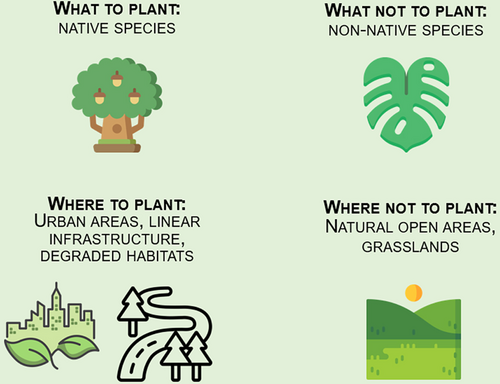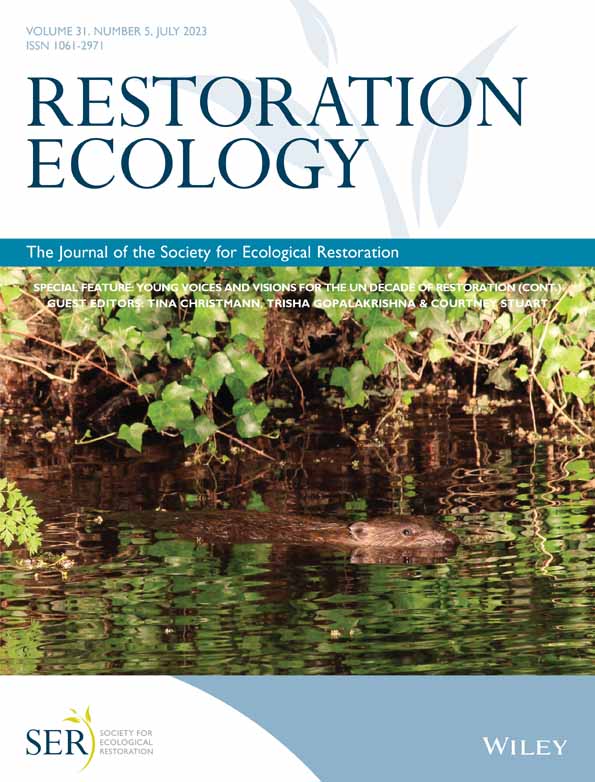Risks of massive tree planting in Europe should be considered by the EU Forestry Strategy 2030
Author contributions: TA, ADG conceived the idea and wrote the manuscript.
Abstract
The EU Forestry Strategy 2030 includes an ambitious reforestation/afforestation plan aimed at planting 3 billion trees that should lead the European Union toward carbon neutrality by 2050. We argue that important ecological aspects were not sufficiently considered in the Strategy. The consequences of large-scale afforestation plans on biodiversity-rich open areas were poorly considered. “Where to plant” is a key aspect, as one of the targets for planting trees may be biodiversity-rich open areas, that are already declining due to natural shrub and tree encroachment. We suggested that urban areas and areas near linear infrastructures should be the main targets of afforestation. Concerning “What to plant” non-native species should be avoided in all cases. Among native species, certain geno-ecotypes may not equally perform under the effects of climate change. We therefore suggest a throughout revision of the EU Forestry Strategy 2030 with the inclusion of ecologically driven principles.
Implications for Practice
- The EU Forestry Strategy 2030, that includes an afforestation plan to mitigate the EU carbon footprint, shows important implementation drawbacks.
- The strategy is generally biased toward the benefits of massive tree planting for carbon neutrality, whilst the potential negative aspects have been poorly considered.
- A risk assessment of potentially negative effects of massive tree planting in biodiversity-rich open areas should be developed and integrated into the Strategy.
- An explicit refusal of non-native plant species for afforestation is lacking.
- In depth ecological considerations on how material for afforestation (at the species and subspecies level) will be chosen, produced and distributed should be integrated into the strategy.
Introduction
The European Union launched an ambitious “Forestry Strategy for 2030” within its Biodiversity Strategy 2030 that, in agreement with the goals of the EU Green Deal, should craft the EU toward the climate neutrality by 2050 (European Commission 2021). Part of the 20 billion €/year for implementing the Biodiversity Strategy 2030 will be committed to planting 3 billion trees, an initiative that was applauded by several stakeholders and citizens.
On one side, we completely support the ambitious afforestation/reforestation plan, because forests as well as trees outside forests (e.g., in cities and agricultural landscapes) provide essential ecosystems services not only related to, but including, carbon sequestration (Gamfeldt et al. 2013). For instance, trees provide timber and other commodities, can contribute to flood and landslides control, mitigate the effects of heatwaves in urban areas through shade and evapotranspiration and contribute to air quality improvement (Boyd et al. 2013).
On the other side, we argue that afforestation plans can be a mean to work-around the true solution of most environmental issues and climate change, that is the reduction of energy consumption and the shift toward more sustainable energy forms.
More specifically, we recognize important limitations and problems in the EU Biodiversity Strategy reforestation plan and, in particular the lack of a well-defined strategy of implementation and the underestimation of some ecological aspects that such plan should consider (Rinaldi 2021). In this paper, we highlight our concerns for a possible unregulated and unplanned massive planting of trees in Europe, we then suggest actions that may partially solve our concerns and finally focus on the role that ecologists and conservation biologists may have in the implementation of the plan. In particular, we focus on two ecological concerns of massive tree planting plans: (1) where not to plant/where to plant (afforestation) and (2) what not to plant/what to plant (afforestation and reforestation) (Figure 1).

Where Not to Plant
Reforestation can be considered a good strategy to reach carbon neutrality, if non-native or even invasive species are used (see below). In the case of afforestation, on the other hand, more caution is needed, because the result of a massive afforestation plan may result in a sharp decrease in open-areas biodiversity (Tölgyesi et al. 2021).
This concern has already been raised for areas where targets of afforestations were naturally open habitats like savannas (Veldman et al. 2015; Bond et al. 2019). This issue is even more important in temperate regions, where forests are typically less species-rich compared to open areas like grasslands (Cousins 2009; Görzen et al. 2019). Open areas have been decreasing for decades in Europe, especially in mountain regions, due to the natural encroachment by woody species mediated by the abandonment of traditional farming practices and by climate change, the latter pushing shrub and tree species upward in elevation other than in latitude (Carboni et al. 2015).
The intentional conversion of large areas of open landscapes into forests may further negatively affect the species typical of open areas. Predictive models suggest complex trade-offs between carbon storage and species richness in the context of afforestation, and even though at the landscape scale, species richness often increases following afforestation (Lautenbach et al. 2017), at the microscale species typical of open areas sharply decline in different types of habitats such as dunes (Katz & Stavi 2020) and grasslands (Buscardo et al. 2008). At 1,500 stems per hectare (European Commission 2021), 3 billion trees would require 2 million hectares of open areas that would be converted into woodlands; the equivalent of more than 12 cities the size of London.
One of the assumptions behind afforestation is that open areas are often the results of past human activities and that forests are “more natural.” Indeed, in Europe, most open areas are likely the result of human activity, but there is evidence that natural grasslands persist in Europe since the end of the last Ice Age, which explain their incredible species richness (Feurdean et al. 2018). Moreover, the conservation importance of open areas is extended to seminatural habitat types by the Council Directive 92/43/EEC of 21 May 1992 on the conservation of natural habitats and of wild fauna and flora “Habitats Directive,” the pillar of biodiversity conservation in the EU. This Directive identifies 28 types of open habitats, including natural and seminatural grasslands, steppes, and meadows that EU Member States must maintain in a favorable conservation status through protection and practical conservation measures. Natural and seminatural habitats identified by the Habitats Directive are protected and should be excluded from afforestation plans. We therefore advise against unregulated tree planting that may result in a decline of species-rich open areas, including unproductive land. On this aspect it is surprising that in the main EU document on the Forestry Strategy 2030 (European Commission 2021) there is a chapter (chapter 1.2) all about the benefits, but nothing is mentioned about real or potential risks.
Where to Plant
Afforestation is most likely to contribute to biodiversity when established on degraded lands. For instance, Liu et al. (2015) showed increased species richness and Shannon Index as an effect of afforestation of highly degraded mobile sand habitats with shrubs. In this case, benefits for soil arthropods in terms species richness and Shannon index came from afforestation-induced changes in nine soil physical and chemical properties. Potential targets of afforestation in Europe could be: (1) abandoned agricultural lands, (2) abandoned mines, spoil dumps, degraded land, and (3) periurban and urban areas. In particular, we support the idea of planting trees along linear infrastructures (par. 3.3.5 of the Strategy) and in urban areas. Infrastructures such as roads, highways, railroads are typically treacherous barriers for migrating wildlife and flora, also in the context of climate change. However, if bordered with trees they may turn into formidable ecological corridors for animals and plants (Kamal et al. 2018) and may also reduce the negative effects of such infrastructures like pollution and noise (Ow & Gosh 2017). Nevertheless, we acknowledge that linear infrastructures may also be important corridors for species of open habitats, thus a trade-off between completely afforested or completely open linear infrastructures should be found (e.g., by adopting both approaches along the two sides of linear infrastructure).
In addition, with recurrent heat waves, cities are more than ever heat islands that in warm record summers become deadly traps for their inhabitants (Macintyre et al. 2018). For instance, in New York City, a massive tree planting project has contributed to strongly reduce fine Particulate Matter (PM2.5) values, with measurable improvements of infant health (Jones & Goodkind 2019). Therefore, greening cities may be another way to increase the benefits for citizens and reduce afforestation pressures on wild open areas (Nyelele et al. 2019). We therefore suggest that cities and linear infrastructures become the primary targets for trees planting. Open areas may also be considered as a target for afforestation if invaded by herbaceous invasive species, but only if they could not be restored.
What Not to Plant
A second concern is related to “what not to plant.” Although the Strategy recognizes the use of native trees is one of the guiding principles, in its implementation criteria it implicitly opens to non-native species if native ones “are no longer adapted to projected climatic and pedo-hydrological conditions.” We argue that the use of non-native (non-European) trees should be avoided, even if they are fast-growing to reduce unpredictable risks of biological invasion or the spreading of new parasites and diseases that may affect the native flora and fauna, already under pressure by alien biodiversity (Popkin 2020). Moreover, in general, the use of non-native tree either for reforestation or for afforestation can decrease plant (Bremer & Farley 2010) and animal (Roberge & Stenbacka 2014) species richness in comparison with native stands or in comparison with more diverse open areas (afforestation).
What to Plant
We firmly state that native species should be the only possibility. However, climate change poses a serious challenge to the use of native species and ecotypes that may not be any more adapted (or will not adapted in the future), to current or future climate conditions. Indeed, at a regional scale even “native” is a rather meaningless concept. Europe span over 30° in latitude comprising 11 Bioregions (as defined by the European Union). A wide array of macro- and microclimatic conditions shaped Biodiversity over millennia, especially during the Pleistocene when alternation of glacial and interglacial period mixed and separated genotypes, causing the evolution of local varieties, ecotypes, etc., that are now adapted to local conditions (Kreyling et al. 2014). The Strategy should consider this aspect, that is becoming even more important in the context of current and predicted climate changes (Fady et al. 2016).
For example, southern ecotypes may already perform better in northern areas where heatwaves and long-standing drought events are increasing in frequency and magnitude. The evolutionary potential of many European tree species may be disrupted if genotypes and ecotypes will be mixed without considering local population traits. The effects of outbreeding depression have been observed in afforestation using different provenance sources of Abies sachalinensis in Japan (Goto et al. 2011) and Pinus armandii in China (Jia et al. 2020). Species Distribution Models combined with experimental assisted colonization trials can help identifying suitable areas based on different climate change scenarios (Bellis et al. 2021). If we adopt an assisted colonization approach in selecting species and sources for reforestation and afforestation plans, we should first establish limits and decision frameworks.
Conclusions
The European Forestry Strategy 2030 is much more than forestry or gardening but need to be rooted in basic concepts from a wide range of disciplines, including (but not limited to) ecology, conservation biology, zoology, botany, molecular ecology, climatology. It is therefore of key importance that foresters, ecologists, conservation biologists including experts in ecological restoration will be involved in the implementation of the strategy. Conservation biologists and ecologists can help developing afforestation decision frameworks rooted in underpinning science of species biology, biogeography, genetics and modeling, all key elements for the strategy. As “the road to hell is paved with good intentions,” we must make sure all relevant aspects are considered in advance to avoid regretting our actions in the future.
Acknowledgment
The Grant of Excellence Departments, MIUR-Italy (ARTICOLO 1, COMMI 314–337 LEGGE 232/2016) is gratefully acknowledged for support provided to T.A.




